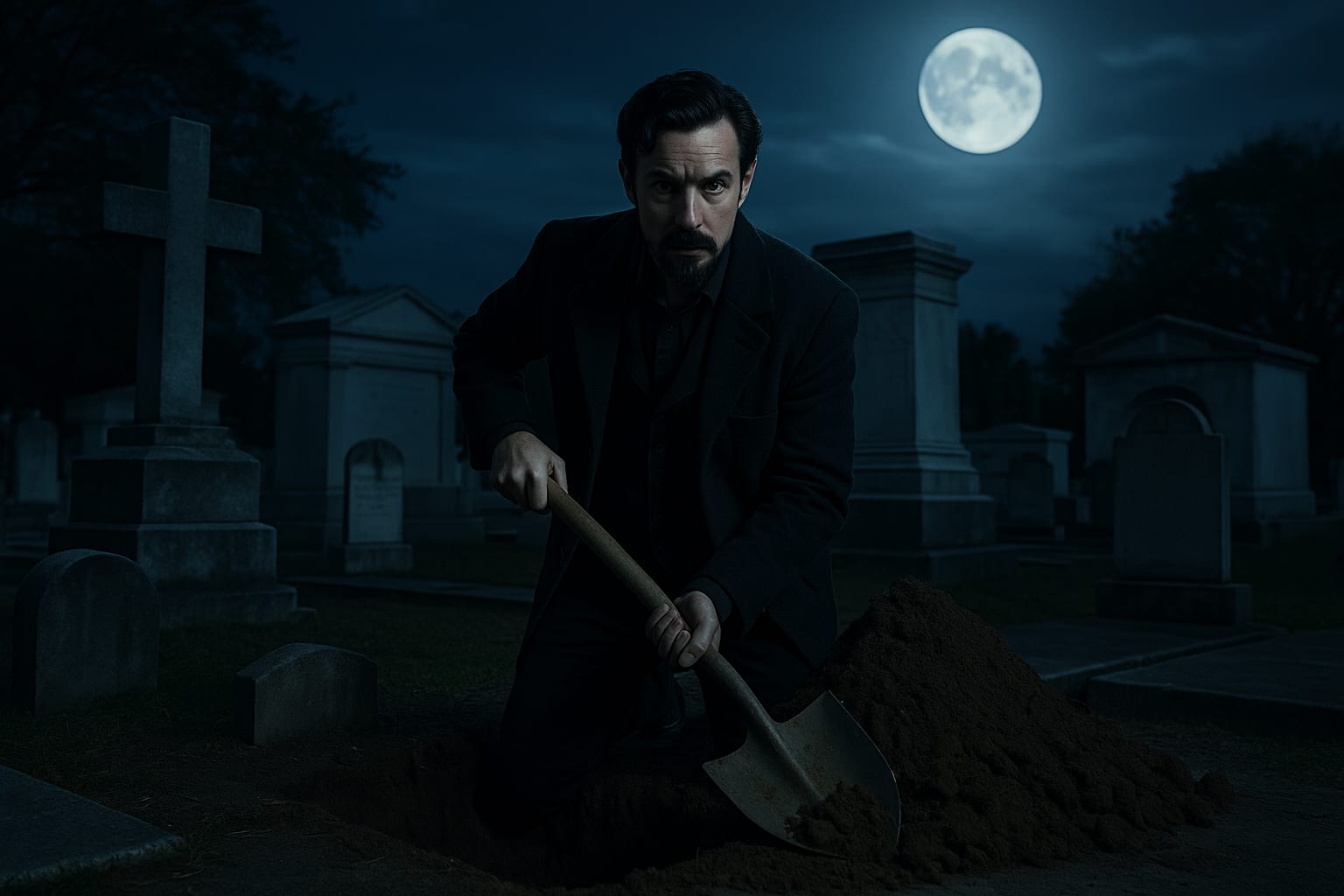Discover the disturbing true story of Count Von Cosel, a German radiologist whose obsession with a young tuberculosis patient led to one of Key West's most macabre tales.
In 1940, Florida's infamous necrophile went on trial for desecrating the body of Elena Hoyos.
Not only were reporters sympathetic to Count Von Cosel's May-December "romance," jurors acquitted Von Cosel of the theft, preservation, and mistreatment of Elena's cadaver. Key West put her corpse on display.
Did You Know?
- Carl Von Cosel was a radiologist who met Elena during an x-ray.
- Elena Hoyos died of tuberculosis at the age of twenty-two.
- Von Cosel robbed her body from the grave.
- He restored her corpse, then kept her cadaver for seven years.
- He was acquitted of all charges.
- Elena was reburied in an unmarked grave.
Who Was Count Von Cosel?
"Creepy, crawly Count Carl Von Cosel" wasn't a count at all. He was a radiologist or x-ray technician. Although some have described him as a "mad scientist," others, a "brilliant doctor," he's more likely a grotesque fetishist.
Even his "penetrating stare and vandyke beard" can't distract you from his obsession with the hospitalized woman in his care.
Boy Meets Girl, Girl Dies, Boy Digs Up Girl's Body
In April of 1930, the "beautiful but doomed" Elena Hoyos arrived at the Marine Hospital for blood tests. She also received x-rays, which is when she met her radiologist, Carl Von Cosel.
Elena's prognosis was grim. She was diagnosed with fast-acting tuberculosis.
Von Cosel Recognizes Elena from a Dream
It was estimated that she wouldn't have long to live, but Von Cosel disagreed. He had become smitten with the frail, Hispanic beauty, and even alleged that he recognized her from a dream.
Ten years before Elena's birth, Von Cosel's ancestor had appeared to him as an apparition. She told Von Cosel that he would marry a young woman who, Von Cosel decided, looked precisely like Elena Hoyos.
Von Cosel Falls in Love with Elena Hoyos
Von Cosel was sixty years of age, and decided that they were to have their May-December romance. He didn't see an issue with their differing ages or her nearly-dead, immobilized status.
Carl Von Cosel decided that he was in love.
He provided free radiation treatments to Elena Hoyos, and a promise of marriage. Elena's consumptive condition meant little to Carl Von Cosel.
Carl Von Cosel's Contraption
Determined to save his newfound paramour, Von Cosel connected her wasting body to his homemade contraption. The invention charged her oxygen electrons with electrodes, which he decided would save her.
Elena was in unbearable pain, but her parents approved of Von Cosel's arrangement. They were comforted by his invention, hoping that perhaps Elena could survive.
Elena Hoyos Refuses Carl Von Cosel
While Elena was undergoing agonizing death, Von Cosel supplied her with perfume, jewelry, fruits, and candies. He showered her with luxurious treats, hoping that Elena would accept his hand in marriage.
He even bought her a mahogany bed, which would become her deathbed. Nevertheless, Elena refused Carl Von Cosel's proposal.
The Death and Desecration of Elena Hoyos
On October 25, 1931, Elena died of tuberculosis at the age of twenty-two. Von Cosel visited her gravesite for two years, a mausoleum in Key West's City Cemetery.
He continued to leave gifts at her graveside – eerie offerings to his lifeless lover, excessive treasures to the object of his affections. He even installed a telephone line to Elena's crypt so that he could continue speaking to her.
Yet Carl Von Cosel was unable to resist peeking at Elena Hoyos. He decided to open her casket.
One so beautiful should not go to dust.
To his absolute horror, Elena's putrefied body had begun to deteriorate. Although he tried to stop her disintegration with embalming fluids, her body continued to decay. Carl Von Cosel's only solution was to steal her remains.
"Mad Scientist" or Grotesque Fetishist?
He transported Elena to his laboratory in the fuselage of a wingless airplane, covertly relocating her body to Rest Beach.
Once he arrived, he replaced her rotting flesh with oiled silk, bee's wax, and balsam. He substituted her empty sockets with glass eyes. He replaced her former beauty with ghoulish, frightening features.
He dressed her corpse in a wedding gown after stuffing her body cavity with rags. He then placed Elena Hoyos on his canopied bed, serenading her with a small, church organ.
Elena remained with Carl Von Cosel for seven years. At least she got to keep her hair.
Life is dormant, inactive, sleeping, in a person who has died. It can be awakened.
Carl Von Cosel Attempts to Rejuvenate Elena Hoyos
Later, Carl Von Cosel believed that he could animate Elena's corpse with ultraviolet ray treatment.
When this was ineffective, he contemplated relocating her remains to the stratosphere. He would personally transport her body by airplane, where Carl Von Cosel believed he could restore her life.
The Body of Elena Hoyos is Discovered
Word caught on that Carl Von Cosel was acting erratically, so Elena's sister decided to investigate. She was never able to unearth her sister's gravesite – Carl Von Cosel was eager to show Elena's sister Elena himself.
He was proud of the excellent attention he'd given to her preservation and thought mistakenly that Elena's sister would feel the same.
The Second Autopsy of Elena Hoyos
Carl's madness was discovered. Authorities took Elena from him.
As they autopsy her body, for a second time, they discovered that she was removed from her tomb two years after her burial. Carl Von Cosel had preserved her corpse for seven years. Carl was doing more than playing dress up with Elena.
Elena's doctors decided to not disclose possibly the most disturbing discovery they had made until after Carl's death. Carl Von Cosel had "consummated" their marriage.
Key West Puts Elena's Corpse on Display
After Von Cosel's arrest, Key West put Elena's body on exhibit. The town's people crowded the funeral parlor, eager to see the macabre curiosity.
Teachers brought their students for field trips; journalists arrived to report on the "most unbelievable story in the world."
Over seven thousand visitors arrived, each desperate to peek at this well-preserved woman. Some asked if Key West could seal Elena within a glass case as a permanent exhibit.
Elena was once again reduced to an object of spectacle, only this time she was a tourist attraction.
Carl Von Cosel is Acquitted
Sympathists flocked to Von Cosel, excusing his bizarre behavior as an "act of love." The County Jail charged him of "malicious and wanton disfigurement of a burial vault," yet the jurors found no law that he had broken.
They were unaware that the doctor had found sperm inside Elena's corpse, clear evidence of necrophilia.
You are living in an insane world. You can be sure that everything that you did was sane. It is perfectly wonderful that you had such a strong love for the girl in this case.
In their ignorance, they asked if it was "illegal to love too much." Carl von Cosel was acquitted. His negative publicity was a small price to pay for such an excessively grotesque desecration.
Elena is Reburied in an Unmarked Grave
Carl Von Cosel was nevertheless unsatisfied with the outcome of his trial. He asked if he could have Elena's body returned to him. Journalists reported that the judge denied Von Cosel's request, screaming at Von Cosel with disgust.
Provoked by Von Cosel's unapologetic behavior, the judge decided to bury Elena in an unmarked grave. Her location was to remain unknown to the creepy, controlling count.
Carl Von Cosel Returns to His Wife and Daughter
After he left Key West defeated, he returned to his wife and daughter in Zephyrhills, Florida. It turns out that Carl Von Cosel was married with children the entire time. (Yes, to a real, live, breathing woman.)
He'd left them to search for his soulmate, which he found in Elena Hoyos.
The Death of Carl Von Cosel
Although reporters wrote that Carl Von Cosel died alone in 1952, this is somewhat untrue. Morticians found him beside his life-size replica of Maria Elena Hoyos, a mannequin reproduction that featured a mask of Elena's face.
Human jealousy has robbed me of the body of my Elena, yet divine happiness is flowing through me, for she has survived death. Forever and ever she is with me.
Key West Responds to Carl Von Cosel
When John Dorschner wrote the sordid details of the case, he was met with remarkable contention. Mrs. C.S. Dickinson, writing from Miami, asked, "Didn't John Dorschner have anything better to do than write his story about Con Von Cosel? Today, it seems even the dead body is no longer respected."
Headlines like "A Key West Story of Necrophilic Love," "Undying Love," and "A Grave Affair" proliferated newspapers, immortalizing the infamous necrophile.
The Ghost of Elena Hoyos
Those sensitive to spiritual energies claim that Elena Hoyos' poltergeist haunts the funeral home of Bahama Lane. Let's hope that they're mistaken and that Elena Hoyos has finally found peace in her second grave.


